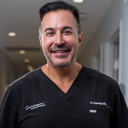Posted underGynecomastia Surgery q&a
Unilateral pseudogynecomastia, what is the best approach? (Photos)
I am 27 years old and started developing pseudogynecomastia since I was 15. A plastic surgeon recommended me to do skin excisions, on one side along with nipple graft and gland removal and only liposuction on the other side without removing the gland. What do you think should I do to achieve symmetry and normal looking chest.
Answers (4)
From board-certified doctors and trusted medical professionals
Dr. Daniel Careaga, MD

Dr. Daniel Careaga, MD
Board Certified Plastic Surgeon
Answer
Dr. Zoran Potparic, MD

Dr. Zoran Potparic, MD
Board Certified Plastic Surgeon
Answer
Dr. James Knoetgen, III, MD
Dr. James Knoetgen, III, MD
Board Certified Plastic Surgeon
Answer
More Gynecomastia Surgery Questions
See all Gynecomastia Surgery Q&AWE SEND PRETTY
EMAILS
What’s trending? Who’s turning heads? Which TikTok myths need busting? We’ve got you. No fluff, no gatekeeping—just real talk. Get our free, unfiltered newsletter.
